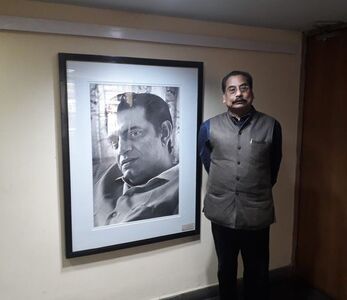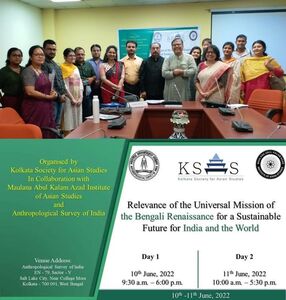The Legacy of Satyajit Ray in Cinema and the Art. History of Bengal Renaissance. Organised by Kolkata Society for Asian Studies at Anthropological Survey of India. June 2022.
Satyajit Ray was considered a Renaissance man, embodying a spirit of comprehensive intellectual and artistic vitality that extended well beyond his professional achievements. It is also due to his multifaceted talents and contributions across various fields of art and culture.
Illustration and Graphic Design: Ray began his career as a commercial artist and brought his skills in illustration to the covers of books and magazines. His eye for design was also evident in his meticulous storyboards and title-sheet for his films.
Filmmaking: Ray is internationally recognized for his profound contributions to cinema. His films, such as the Apu Trilogy, are celebrated for their deep humanism, intricate characterization, and narrative subtlety. He had a holistic approach to filmmaking, often taking on the roles of writer, director, and composer for his films.
Music: Ray composed the scores for many of his films. His deep knowledge of Western classical music and Indian classical music allowed him to create scores that enriched the emotional landscape of his films. He has also composed music for other directors.
Intellectual Curiosity: Ray was known for his wide-ranging interests, from science and technology to philosophy and art, which is a hallmark of a Renaissance personality. He was deeply involved in the intellectual and cultural life of Bengal and India, often engaging with major global and local issues of his time. Ray was known for his curiosity and deep knowledge in a variety of subjects, including music, literature, art, history, and science. This wide breadth of interests allowed him to engage in meaningful discussions and explorations beyond his immediate professional needs.
Cultural Engagement: Ray was deeply immersed in both Western and Indian cultural landscapes. He was an avid reader and an enthusiast of Western classical music, as well as Indian classical and folk music, often incorporating these influences into his own work. Ray's works often reflected his profound understanding of the social, cultural, and economic complexities of Indian life. He was known for his ability to translate these complex realities into compelling cinematic and literary forms, making significant contributions to not only Indian culture but also to world culture.
Innovative Thinking: In his personal life, Ray showed a penchant for problem-solving and innovation, whether in devising a new way to shoot a scene with limited resources or in tinkering with electronic gadgets at home.
Literary Contributions: Ray was also a prolific writer and illustrator. He wrote several novels and short stories, primarily aimed at children and adolescents. Perhaps his most famous creation in literature is the detective Feluda and the scientist Professor Shonku, characters that have become iconic in Bengali literature.
Mentorship and Influence: Ray was also known for his role as a mentor and his efforts to nurture young talent in film and the arts, reflecting his personal commitment to the development of culture and the arts in India.
Social and Ethical Concerns: His films and writings often reflect a personal concern for ethical and social issues, showing his engagement with the challenges of his times.
These diverse talents and his ability to excel in multiple domains of creativity and intellectual pursuit make Satyajit Ray a true Renaissance man, reminiscent of the broad and versatile geniuses of the Renaissance period in Europe.
KANTHA: embroidered cultural history. AIR Talk. June 2022.
Kantha is an embroidery craft practiced by women in Bengal, typically using old saris and cloth and layer them with stitching to make a light blanket, throw, or bedspread, especially for children. The simple Kantha made at home after the birth of a child and used as a spread is called ‘Muthuna Kantha’ in colloquial terms meaning loosely ‘Wet Cover’. The 300 year old Kantha hanging at our home falls in this category and is more important due its place of origin in East Bengal, now Bangladesh and for its simple design. Also for the fact that the design has children dressed up, probably with shoes, which is amazing. As in all family myths, the story of birth is remembered as a dramatic technicolour dream and the Kantha plays a pivotal role. Kantha stitching is also used to make simple quilts, commonly known as nakshi kantha. Old sarees are also stacked on each other and hand-stitched to make a thin piece of cushion. This is normally used as a bed cover. Kantha saris are very popular and are traditionally worn by women in Bengal region. Nowadays, 'kantha stitched’ kurta (or panjabi) and churidar and many other garments and gaining popularity due to their aesthetic value and handmade characteristics.
Will 'Sidhu Jyathas' be ever born again in Bengal? September 2021.
A candid Conversation between Dr Partha Sarathi Mukherjee, Founder, Director, BFIC and the Illustrious Professor Aloke Kumar.
With Google almost in every home, will 'Sidhu Jyathas' be ever born again in Bengal? Or is the era of Antiquarian over? Does Bengal and Kolkata need its own dedicated archive showcasing Antiques, Memorabilia, Collections and Souvenirs from Its Glorious past... for tourists, visitors, researchers and enthusiasts?
Nurturing Heritage through Art Leadership. April 2020.
Understanding the importance of Intangible culture is important to keep the tradition alive, understand its relevance in the contemporary scene, and to nurture artisans for making a sustainable development for artists and communities.
Stories of World Culture. World Peace. April 2020.
Indian Museum Series. Ministry of Culture, Government of India.
World peace suffered a series of setbacks last year because of the COVID-19 pandemic. Between January 2020 and April 2021, pandemic-related violent incidents were recorded in at least 158 countries. These incidents ranged from individual attacks aimed at people of Asian descent through to anti-lockdown demonstrations that turned violent. Understanding the meaning and relevance of World Peace in today’s context.
I N D E P E N D E N C E Day in the Age of Digital. All India Radio. AIR Talk. August 2014.
Our Independence Day Celebration meant wearing our school uniform and rushing to school in the early morning to hoist the flag and sing the national anthem in full throated emotion. This transformed into dressing up early and joining the community in hoisting the flag watching the young boys and girls singing the National Anthem and Vandamattaram , not of Bankim but of A R Rehaman. With the Prime Minister of our country for the first time being born on the other side of the Independence has made a marked difference at the way we think of our Independence Day.





